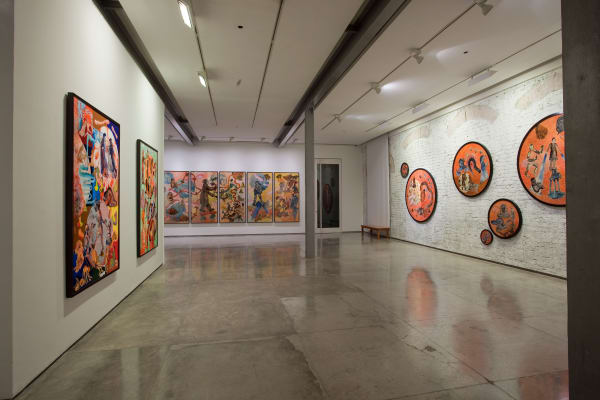Splitting the Other: Nalini Manali
‘Splitting the Other’ was not only the title of Nalini Malani’s magnus opus for the 52nd Venice Biennale but also the title of her seminal retrospective from the period 1992 to 2009 at the Musée Cantonal des Beaux-Arts in Lausanne. At Chemould Prescott and Chatterjee & Lal a small but representative selection was shown from the Lausanne retrospective that not only included paintings, video installations, artist’s books but as well a new theatre performance with Alaknanda Samarth, wall drawings and a special closing event.
With this exhibition a special book was published, with in depth writing by specialists Whitney Chadwick, Doris von Drathen, Bernard Fibicher and Andreas Huyssen. A DVD is included in the book and contains a complete overview and description of Nalini Malani’s time based productions.
The fourteen panels of the cycle ‘Splitting the Other’ present a procession of human figures, monsters and angels, free-floating brains and grub-like entities peering through blank, sightless eyes, of canons, bones, anti-tank mines, umbilical cords and embryos, a world similar to the one in some of Hieronymus Bosch’s paintings. Nalini Malani tries to bring together, on a truly epic scale, all periods and all cultures, she tries to multiply the perspectives, and to evolve outside hierarchies and identities.
One figure stands out by nature of its proportions: an imposing Genitor of the World Wanderer. Not only are the umbilical cords growing out of her womb, but issuing from her arms and hands are broad veins supplying nutrition that bulge out into the surrounding space and adopt the form of an oscillating, hose-shaped vertebral column. This figure appears twice in the sequence – once as a vigorous young mother, then as a tired, aged woman visibly slumped and wheezing, with a dark cloud of breath before her face. The blood vessels of the old woman nourish innocent newborns as they float in space behind her, but she is also supplying food to monsters and hideously grimacing, toad-like creatures that bar her path.
The giant woman embodies a variety of mythical and legendary characters, such as Medea, Mother India, Sita, Mother Courage and Alice. These timeless characters become actresses in the Indian reality. For, like Medea’s appearances, the worlds she traverses are inscribed in the brutal present of the pogroms unleashed by Hindus against Muslim, which erupted again in 2002 when another wave of rape and mass murder struck Muslim families and ravaged their quarters. Malani epitomizes all those minorities that in the course of the history have been wrongly accused, persecuted, and subjected to pogroms. She is ‘the other’ - a chimerical externalization of the (self-directed) aggressions that every society is capable of projecting, splitting off and transferring onto others at every moment.
Nalini Malani | Splitting the other
November 1 – 30, 2010
Excerpt from: Bernard Fibicher | Splitting the Other: a new epic voice?
Introduction
No single viewpoint and no single image. The artist proceeds in series, or in cycles based around a theme or a figure, that sometimes last several years, or in polyptychs. She takes no interest in single works, which are dependent on the (masculine?) concept of the masterpiece, the fruit of the intimate encounter between the artist and the work on the easel, and which falls perfectly within the field of vision of the motionless person. Rather, she prefers the spirit of the fresco, which allows her to present- and for the observer to piece together - a universe of relationships and transformations. While accepting the impossibility of understanding the totality of the world, cycles and polyptychs allow us to travel through eras and cultures, to multiply our perspectives, to work outside of hierarchies and identities, to open up to the multiple, the polymorphic, the fluctuant, the discontinuous, and to argue for participation on a relational level. In attempting to integrate as many spatial-temporal levels as possible, the works of Nalini Malani have an almost encyclopedic goal. Indeed her undertaking has all the characteristics of an epic.
Splitting
The term “splitting” (Spaltung in German)- with its connotation of violence, as in the vigorous swing of an axe to split a log – is, of course, also part of the basic vocabulary of psychoanalysis (Freud speaks of Ichspaltung). It describes the dissociation of personality, not only in the paradigm of the dissociation of the selfcalled schizophrenia, but more generally as the eruption of the self that “bursts into pieces”; it thus denotes the inverse process of association and integration. This primary division, this forced separation - a sort of big bang of human consciousness – is the point of departure for the investigations carried out by Nalini Malani and becomes the driving force of all sorts of attempts at reunification.
The Other
The heroes of Malani’s epic- her Other- are women. They are the instruments of transcendence. The names she gives them are Cassandra, the woman who predicted the fall of Troy but whose message fell on deaf ears; Akka Mahadevi, the priestess of Shiva, who refused to marry and of whom some of the most powerful men of her time became disciples; Medea, who, in the interpretation of Christa Wolf, is the woman who discovered what transpired behind the scenes of power, was accused of all evil-doing, and who accepted responsibility; Lewis Carroll’s Alice, who challenges the established order of the real world; the divinities Sita and Radha; and the allegorical Mother India.
The chapter is included in: Nalini Malani | Splitting the other | Hatje Cantz | 2010



